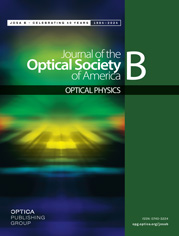Journal of the Optical Society of America B (JOSA B)
The Jaynes-Cummings Model: 60 Years and Still Counting
Submission Opens: 1 December 2023
Submission Deadline: 15 March 2024
The Jaynes-Cummings (JC) model was based on a paper by E.T. Jaynes and F. W. Cummings, published in January 1963, and consisted of a two-level atom coupled to a single mode of the electromagnetic field. It led to the discovery of signatures of coherence, with the most paradigmatic being the collapses and revivals of the atomic inversion for an initial coherent state of light. Experimental work within cavity QED brought the model to the lab, and things developed further in the 1990s with the advent of quantum information processing. Most recently, we’ve witnessed groundbreaking experiments in both cavity QED and trapped ion systems, and how circuit QED has emerged as one of the most promising platforms for implementing QIP schemes, owing to its extended scalability and very low decoherence times.
This feature issue will highlight developments stemming from the fundamental model of quantum optical resonance known as the Jaynes-Cummings model.
Topics to be covered include but are not limited to:
- Cavity QED
- Photon blockade
- Applications in quantum technologies (quantum computing, etc.)
- Trapped Ions
- Circuit QED
- Ultrastrong coupling, integrability
- Quantum phase transitions
- Molecules in cavities
- Generation of nonclassical light
- Polaritons
All papers need to present original, previously unpublished work, and will be subject to the normal standards and peer-review process of the journal. Manuscripts must be prepared according to the usual guidelines for submission to JOSA B and must be uploaded through the Prism submission system. When submitting, please specify that the manuscript is for the "The Jaynes-Cummings model: 60 years and still counting" feature issue (choose from the drop-down menu).
Feature Issue Guest Editors
Jonas Larson, Stockholm University, Sweden (Lead Editor)
Themistoklis Mavrogordatos, Stockholm University, Sweden, and ICFO—The Institute of Photonic Sciences, Spain
Scott Parkins, University of Auckland, New Zealand
Antonio Vidiella-Barranco, University of Campinas, Brazil

